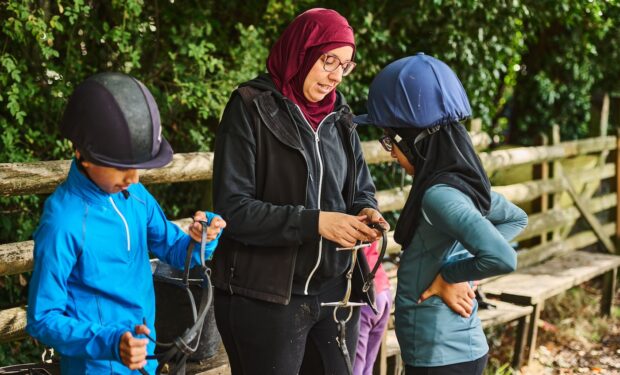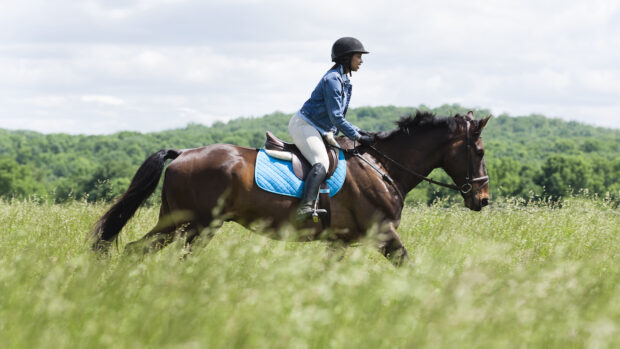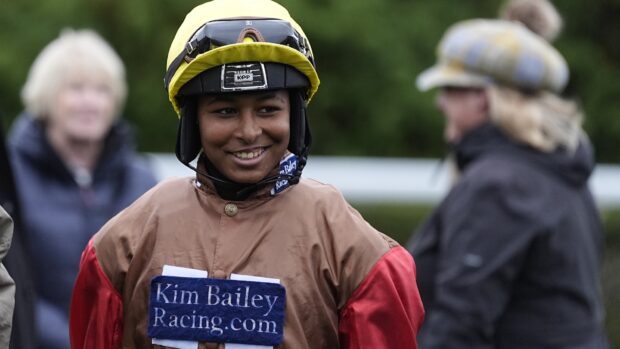A REPORT on under-represented communities within equestrianism is an “exciting” opportunity to make real, lasting change in the industry, it is hoped.
British Equestrian (BEF) commissioned major research last year, aiming to “discover the barriers to participation in equestrian sport and activity from the perspective of ethnically diverse communities and or those from a low socio-economic background”.
AKD Solutions, which carried out the research, made recommendations on how the industry should act, and as a result, the BEF has set out its short-, medium- and long-term commitments.
“Everyone wants this to happen,” BEF head of participation Mandana Mehran Pour told H&H. “The interest is there and that’s the most important part; we all want to do this and we’re going to find out how.”
AKD was asked to speak to 800 people, Black, Asian and from other ethnicities, and those from “under-served” communities, to learn more about perceptions, engagement and interest in equestrianism, and understand the barriers to it. It included a nationwide survey, interviews, forums and equestrian experience days.
Headline results included that 46% of respondents would take part in, or consider taking part in, equestrian activity. Some participants felt the industry could learn from the increasing inclusivity of racing, and from the impact of money invested in young Black and Asian talent.
It was found that participation by Asian, Black and “mixed” groups would be encouraged by improved access to information and better representation in the industry – 76% of people said they agreed with the statement “people like me are underrepresented in horse riding and other horse-related activities”.
Factors that would increase participation were found to be seeing more participants like themselves, more available information about equestrian activities, taster sessions and promotional material featuring “people like me”. More affordable equestrian activities was also a factor. Barriers were named as lack of awareness of such activity and affordability.
But 24% felt that racial discrimination adversely affected their ability to fully access and benefit from horse-related activities.
One mixed-heritage participant said that with her heritage and “class connotations that are inextricably linked with the sport”, she did not believe she could belong. A Black respondent said not seeing top riders who “look like me” was a deterrent, and a mixed-heritage respondent had ridden once, as the only non-white person there, and “did not feel welcomed”.
“She stands out because she isn’t white,” one Asian equestrian wrote. “We notice the additional criticism we face because we’re not white; we have to work harder, be better.” Incidents of bullying and racialised experiences emerged.
“People may feel racism or bullying every day, and everywhere,” Ms Mehran Pour said. “We know we have to support our industry to be a bit more welcoming and more inclusive to everyone, regardless of background or the colour of their face.”
AKD’s recommendations include a universal commitment to anti-discriminatory equestrian environments, building strong partnerships with alternative structures and diverse spaces, planning generationally and leading from the front on diversity.
“This report presents a huge opportunity to make equestrianism inclusive and more diverse,” the report states in AKD’s reflections. “Through collaborative, targeted and adequately resourced opportunities in less affluent and ethnically diverse communities, the equestrian industry can benefit from wider engagement, more talent and investment.”
The BEF said the report was “a hugely beneficial base” to understand the current situation, and give clear guidance on progressing its equality, diversity and inclusion (EDI) strategy.
“It is imperative we see this as a catalyst for driving positive change that will help shape the future of equestrianism,” it states in its response. “We acknowledge that creating meaningful and lasting change will take time but collectively we are committed. This is just the beginning of our journey towards building a more inclusive equestrian community that is reflective of Great Britain.”
The BEF’s commitments are based on the recommendations, and Ms Mehran Pour said: “This is a generational movement.
“In the next 15 years, we will see people from different backgrounds being comfortable, and it will be quite visual. One thing brought up in the report was people not being welcome at riding schools or livery yards, but people from white British backgrounds had the same issues. My aim in 10 years’ time is to have more welcoming environments, whoever you are. That’s my vision.”
Ms Mehran Pour said everyone in the industry can contribute by being more welcoming, but that in the main, the issues raised are “cultural, not equestrian”.
“We’re not alone in this,” she said. “If anyone has had issues, we’re here to listen as unless we know where the problems are, we can’t fix them. And if we do our bit in our sport, we’re doing it for all society. The hope is creating more welcoming, understanding people for society, not just the riding population.”
Another key finding is that all those who had not ridden before and did so for this report “absolutely loved it”.
“It’s the magic of horses,” Ms Mehran Pour said. “People want to be involved but think they can’t for financial reasons or because they don’t see people like them but the latent demand is absolutely essential.”
She added: “This is really exciting and I’m proud of everyone in the federation and member bodies. People want to make the change and that’s the most important thing. If you want to do something, you’ll find a way to do it.”
British Showjumping (BS) CEO Iain Graham told H&H the member bodies will work with the BEF to deliver on all the commitments.
“We’ve all been doing our bit to try to make sure as organisations we’re welcoming to everyone but it’s really useful to have independent recommendations,” he said, adding that BS appointed a director for EDI two years ago, and has plans in this area.
“One of the benefits of our sport is that men and women compete equally so there’s no gender separation,” he said. “But everyone is equal in the horse’s eyes; the horse doesn’t care what your background is.”
British Dressage (BD) CEO Jason Brautigam told H&H BD is committed to ensuring the sport is inclusive and accessible to all.
“We have a lot to celebrate in this regard – men and women compete on an equal basis, with riders from eight to 80 taking part in dressage, while we also have a successful record in disability sport, and strong representation from the LGBTQ+ community,” he said. “However, we acknowledge that equestrianism is not as ethnically diverse as we would want it to be, while there are communities that are currently under-represented and under-served, particularly in less affluent urban areas. There are many socio-economic factors that contribute to this, but we want to break down any barriers that exist to participation and ensure that our sport is welcoming to everyone.
“This report identifies some of the areas where we need to focus our efforts, as well as recognising the strong foundations we can build on. I was personally very heartened by the findings, as it reveals that there is a latent demand to take part in equestrian sport and highlights where there are opportunities to promote dressage to a wider audience. We will work collectively with other member bodies across the federation to address these inequalities and collaborate with groups that have already established excellent initiatives in this area.
“We have set aside designated funds from our reserves specifically for outreach projects to bridge the gaps that currently exist, and the feedback in this report will help us to deliver meaningful, tangible, and long-lasting change.”
British Eventing (BE) CEO Helen West added that BE is committing to “leading from the front and encouraging a culture that actively encourages diversity and inclusivity”.
“BE is proactively developing alignments that can assist us reach these objectives,” she said. “We recently delivered a The Howden Way Academy [BE’s training framework] session to a group of diverse riders from Cool Ridings. It was such an inspiring day, which was a success on so many levels.
“Our focus is unwavering on ensuring that we create a welcoming and nurturing environment for riders from underrepresented groups that have an interest in eventing. We applaud the undertaking of the report, its findings and recommendations.”

Simba Chinyemba of SLC Veterinary Physiotherapy had some concerns about how he would be accepted in a white-dominated industry. Having ridden as a child and a teenager, he considered veterinary medicine as a career but settled on physiotherapy as a middle ground.
“I haven’t really had any bad experience in terms of racism or barriers to opportunities but it crossed my mind a bit,” he said. “A bit of concern about how seriously I’d be taken, but I think it does work to my benefit as people remember me.”
Mr Chinyemba said he hopes he might be able to inspire others into the industry, and recently spoke at an equine careers event at Bishop Burton College.
“I hope by putting this out there for people to read, it can give confidence to other people who share the same concerns that I once had,” he told H&H. “I know for many other people, the fear of not being accepted can stop them even attempting to enter an industry or profession.”
Pippa Winkworth, co-chair of the National Association of Veterinary Physiotherapy (NAVP), told H&H vet physios have mainly been white females, and the NAVP is keen to attract applicants from all backgrounds.
“Existing NAVP members from ethnic minority groups, who initially felt concerned about the possibility of issues arising about gender or ethnicity, have been pleasantly surprised by how welcoming and open the association, wider industry and the public have been,” she said.
“Anyone is welcome if they are passionate about animal care, veterinary physiotherapy and can meet the requirements of membership. With the recent change of management at NAVP, we are evaluating our equal opportunities and diversity policy, as well as looking at ways we can reach out ethnic minority groups.
“NAVP is committed to and proactive in achieving excellence in equality of opportunity of our members, including all under-represented groups. We want to promote an inclusive culture and we value diversity. One of our core values is freedom from discrimination. All membership will be determined by personal merit and by performance. No student, member of the association, executive team or applicant for admission as a member will be treated less favourably than another because of their belonging to a protected group.”
You might also be interested in:

Two young showjumpers aspire to be first mixed-heritage British Olympic riders

Young equestrian entrepreneur’s dream to inspire as diversity work continues

New coaching scheme aims to transform lives

Subscribe to Horse & Hound magazine today – and enjoy unlimited website access all year round
Horse & Hound magazine, out every Thursday, is packed with all the latest news and reports, as well as interviews, specials, nostalgia, vet and training advice. Find how you can enjoy the magazine delivered to your door every week, plus options to upgrade your subscription to access our online service that brings you breaking news and reports as well as other benefits.




